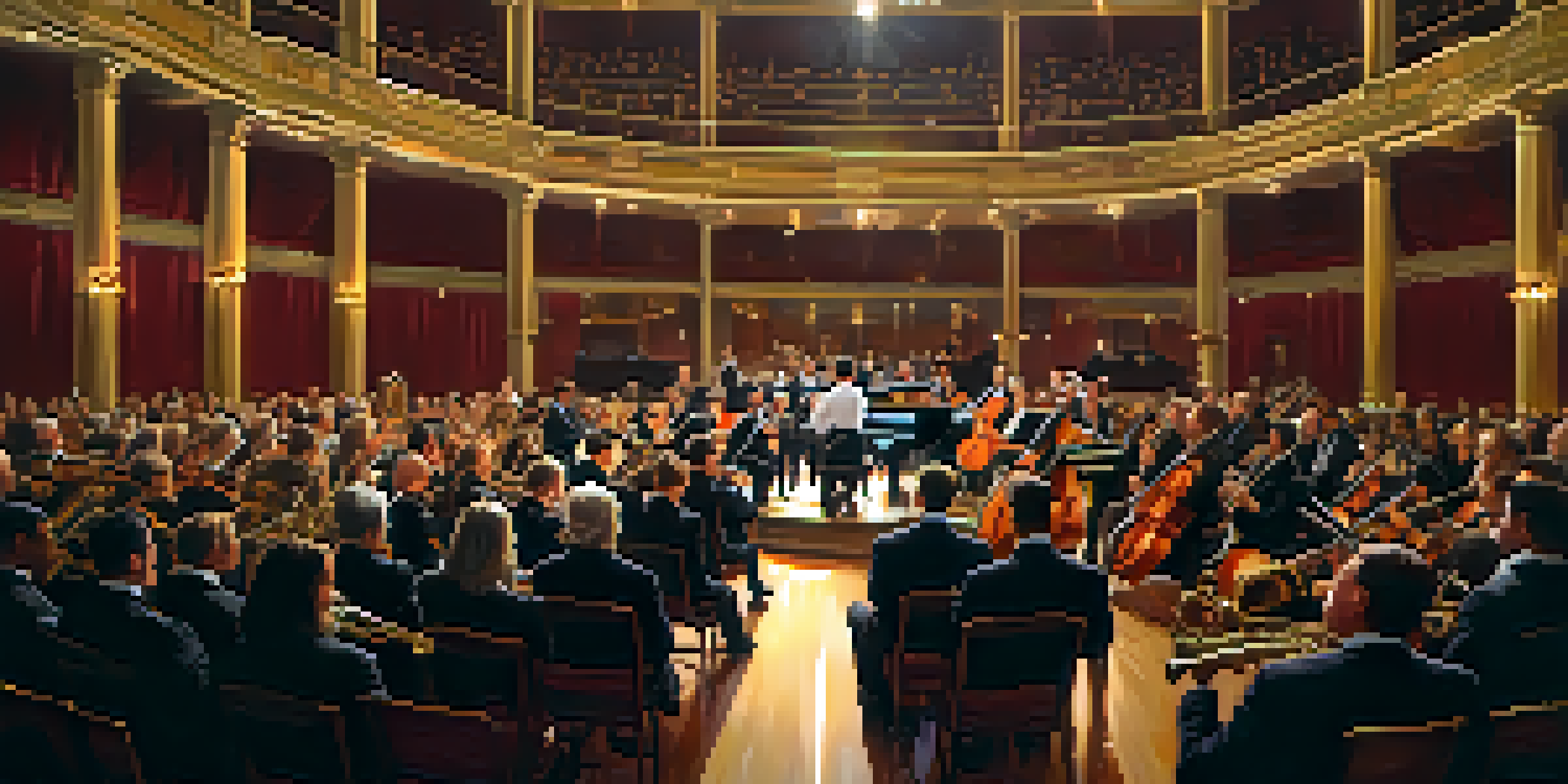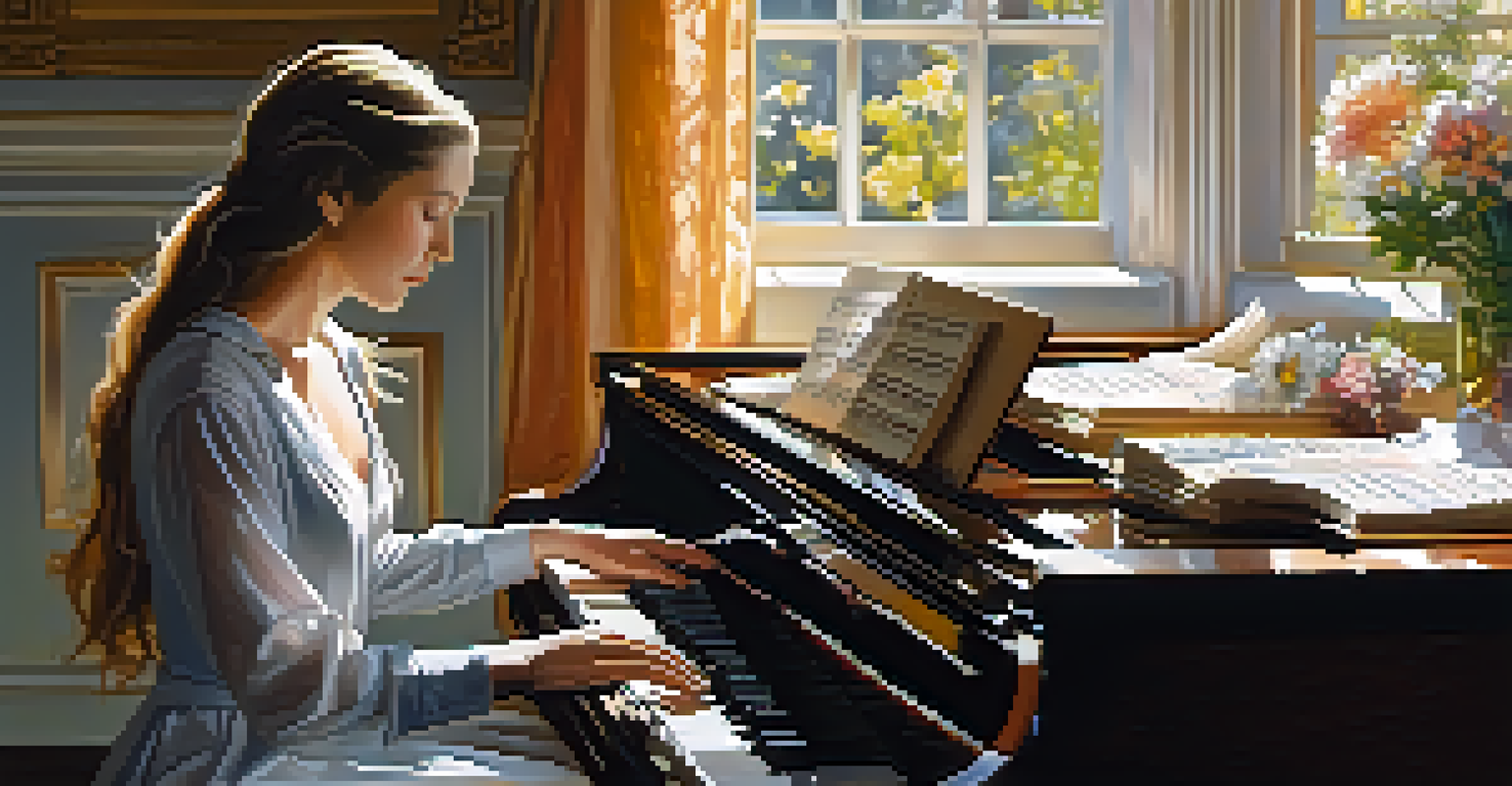Classical Music and Its Diverse Cultural Influences

The Origins of Classical Music and Its Cultural Roots
Classical music has a rich tapestry of origins that stretches back centuries. It draws from various cultural influences, particularly from European traditions like Italian, French, and German musical styles. For instance, the use of harmony in classical compositions can be traced back to the early polyphonic practices in medieval Europe.
Music is the shorthand of emotion.
Beyond Europe, classical music has also absorbed elements from different cultures, such as the rhythmic patterns of African music and the melodic structures of Eastern music. This blending of traditions showcases how classical music is not a standalone genre but rather a dialogue between diverse cultures. Each new influence brings fresh ideas, enriching the overall experience.
As composers like Bach and Mozart incorporated these varied elements, they helped shape the sound of classical music we know today. By embracing these cultural exchanges, classical music has become a dynamic art form that continues to evolve, reflecting the world around it.
The Role of Folk Music in Shaping Classical Compositions
Folk music has played a pivotal role in the development of classical music, often serving as a source of inspiration for many composers. For example, Bartók famously collected and integrated Hungarian folk melodies into his compositions, which not only celebrated his heritage but also introduced new rhythms and scales to classical music. This practice highlights the importance of cultural identity in artistic expression.

Many classical composers, including Dvořák and Copland, have drawn from the folk traditions of their respective countries, infusing their works with a sense of place and authenticity. This cross-pollination creates a unique listening experience, as audiences can feel the heartbeat of different cultures through the music. It's like traveling through sound, where each piece tells a story rooted in tradition.
Cultural Roots of Classical Music
Classical music is a rich tapestry woven from various cultural influences, showcasing a dialogue between diverse traditions.
Moreover, the integration of folk elements into classical music has allowed for greater accessibility, bridging the gap between high art and popular culture. This democratization of music invites more people to engage with classical compositions, fostering a deeper appreciation for its diverse influences.
How Religion Influenced the Development of Classical Music
Religion has significantly shaped classical music, particularly through sacred music like masses and oratorios. Composers such as Handel and Bach created works that were not only musically profound but also deeply spiritual, reflecting the beliefs and values of their time. These compositions often served as a means of worship, uniting communities through shared musical experiences.
The composer’s task is to make sure the music is as diverse as the world we live in.
The use of religious texts and themes allowed composers to explore complex emotions and narratives, providing listeners with a sense of solace and connection. For instance, Bach's 'Mass in B Minor' is a masterful blend of musical technique and spiritual expression, showcasing how faith can inspire artistic brilliance. It's a testament to the power of music in conveying profound messages.
As societies evolved, the relationship between religion and classical music transformed, leading to a broader exploration of themes beyond the sacred. This shift has allowed contemporary composers to draw from various spiritual traditions, further enriching the classical repertoire and demonstrating the genre's adaptability.
The Influence of Nationalism in Classical Music
Nationalism emerged as a powerful influence in classical music during the 19th century, as composers sought to express their cultural identities through their works. This movement encouraged artists to draw inspiration from their native folk traditions, creating music that resonated with national pride. For example, composers like Smetana and Dvořák infused their compositions with Czech elements, celebrating their heritage.
This trend was not just limited to one region; it spanned across Europe, with composers like Grieg and Sibelius reflecting their Scandinavian roots in their music. These nationalistic elements allowed audiences to connect with the music on a deeper level, as it echoed their own experiences and cultural narratives. It was a way to assert identity and shared history through the universal language of music.
Folk Music's Impact on Composition
Folk music has been a significant source of inspiration for classical composers, allowing for a unique blend of cultural identity and artistic expression.
In modern times, the legacy of nationalism in classical music continues to inspire composers from various backgrounds. This ongoing exploration of cultural identity fosters a rich and diverse musical landscape, making classical music a living testament to the myriad influences that shape our world.
Exploring the Impact of Globalization on Classical Music
Globalization has had a profound impact on classical music, allowing for a fusion of styles and traditions from around the world. As artists connect across borders, they exchange ideas, techniques, and cultural influences that enrich their compositions. This blending can be heard in the works of contemporary composers who incorporate elements of jazz, pop, and world music into their classical pieces.
For instance, composers like Tan Dun have integrated traditional Chinese instruments and motifs into orchestral works, creating a unique sound that bridges cultures. This cross-cultural collaboration not only broadens the appeal of classical music but also introduces new audiences to its timeless beauty. It’s like a musical potluck, where everyone brings their favorite dish to share.
Furthermore, the accessibility of music through digital platforms has made it easier for diverse voices to be heard. As a result, classical music is becoming more inclusive, reflecting a variety of cultural narratives and experiences. This evolution is a reminder that music is a living art form, constantly adapting to the changing world around it.
The Contribution of Women in Classical Music History
The contributions of women in classical music have historically been overlooked, yet their impact is undeniable. Composers like Clara Schumann and Fanny Mendelssohn broke barriers in a male-dominated field, creating beautiful works that deserve recognition. Their perseverance paved the way for future generations of female composers to express their artistic voices.
In recent years, there has been a resurgence of interest in women composers, leading to a reevaluation of classical music history. Works by composers such as Lili Boulanger and Florence Price are being performed and celebrated, highlighting the richness of their contributions. This newfound recognition allows audiences to experience a more inclusive narrative within classical music.
Women’s Contributions to Classical
Historically overlooked, women have made significant contributions to classical music, and their growing recognition enriches the genre's narrative.
Moreover, the growing visibility of women in orchestras and conducting positions signals a shift toward greater equality in the classical music world. As more female artists take center stage, they inspire young musicians and composers, demonstrating that talent knows no gender boundaries. This evolution enriches the classical music landscape and fosters a more diverse artistic community.
The Future of Classical Music Amidst Cultural Diversity
As we look to the future, the cultural diversity within classical music is likely to expand even further. Composers are increasingly drawing inspiration from a multitude of cultural backgrounds, blending genres and styles to create innovative works. This trend reflects a globalized society where collaboration and cross-cultural exchange are celebrated, paving the way for a vibrant musical future.
Additionally, the rise of technology has opened new avenues for creativity, allowing composers to experiment with digital tools and multimedia elements. This evolution creates exciting possibilities for classical music, making it more accessible and engaging for contemporary audiences. Imagine a symphonic concert that incorporates visual art and interactive elements—it's a thrilling prospect!

Ultimately, the future of classical music lies in its ability to adapt and evolve. By embracing cultural diversity and fostering inclusive practices, classical music can continue to resonate with audiences around the world. As we celebrate this rich tapestry of influences, we also honor the transformative power of music to unite and inspire.